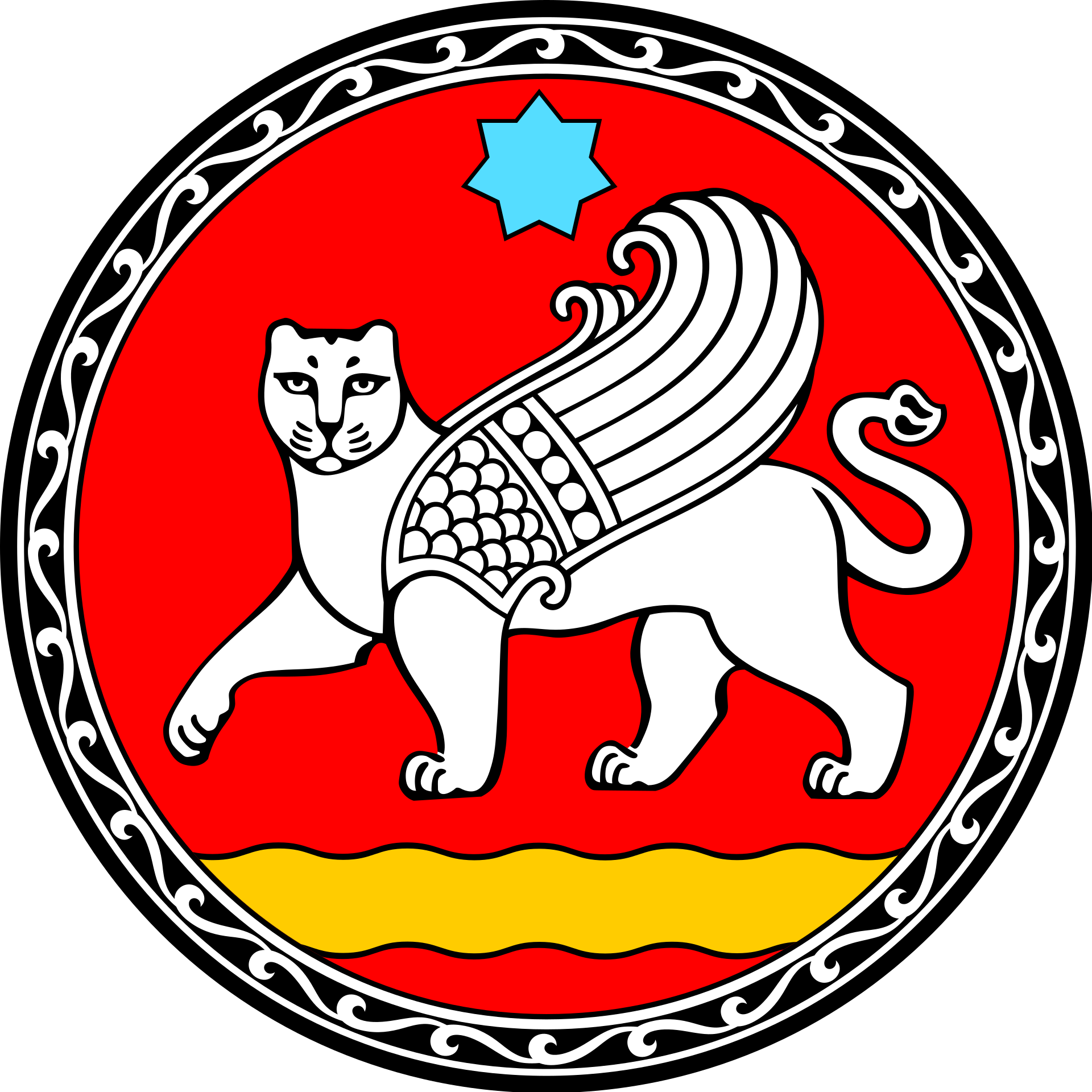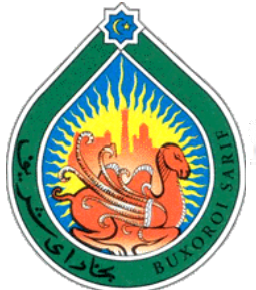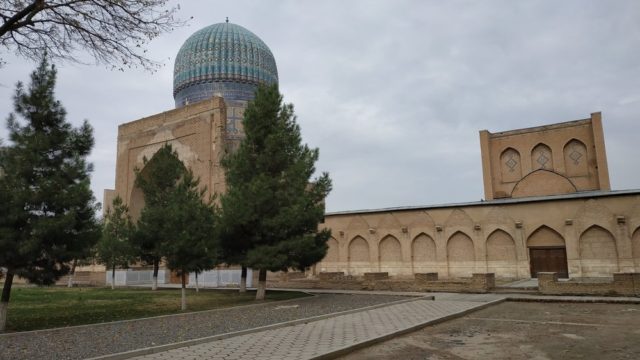
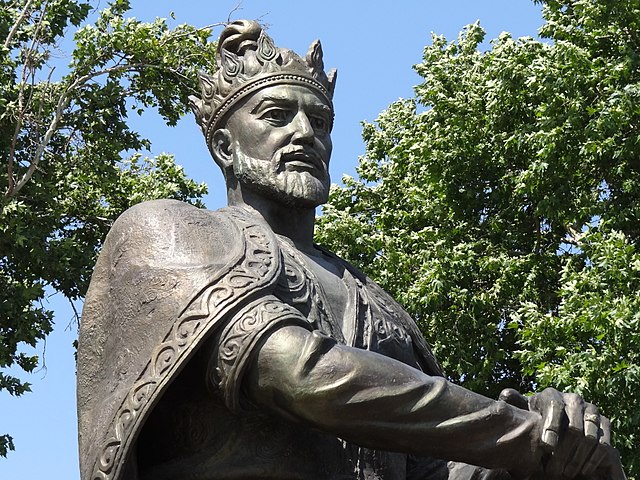
|
Amir Temur Mosque and the Mausoleum of Bibi-Khanym
It is known under a name of the legendary wife of Amir Temur: Bibi-khanym (Saray-Mulk-khanym). There is a legend that she constructed this building as na expression of love to her husband. Actually it was built as the main mosque by order of Amir Temur after Ms Indian campaign. The construction of the building began in 1399 and was finished in five years. The powerful entrance portal strengthened with the towers- minarets (up to 50 meters high) on the comers. The portal of the main building acts as a mihrab.
In the centre of court yard there is a huge marble stand for the Koran (laukh). It was made at the time of Ulugbek, Amir Temur’s grandson. In later time (XVI-XVIII centuries) this stand was used by some rulers of Uzbek dynasties as original “throne”, where the khan was rested on white felt.
Amir Temur (Tamerlane) -
(1336-1405)
Went down in history as a great statesman who made invaluable contribution to world civilization. Samarkand was the capital of the vast empire united the territory of 27 countries of today. Amir Temur decided to outshine all of capitals in the world by the grandeur and beauty of Samarkand. |
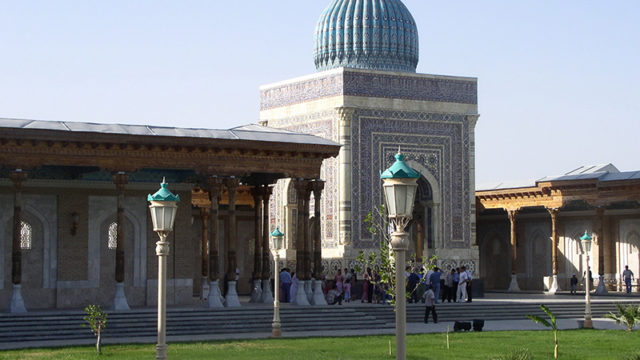
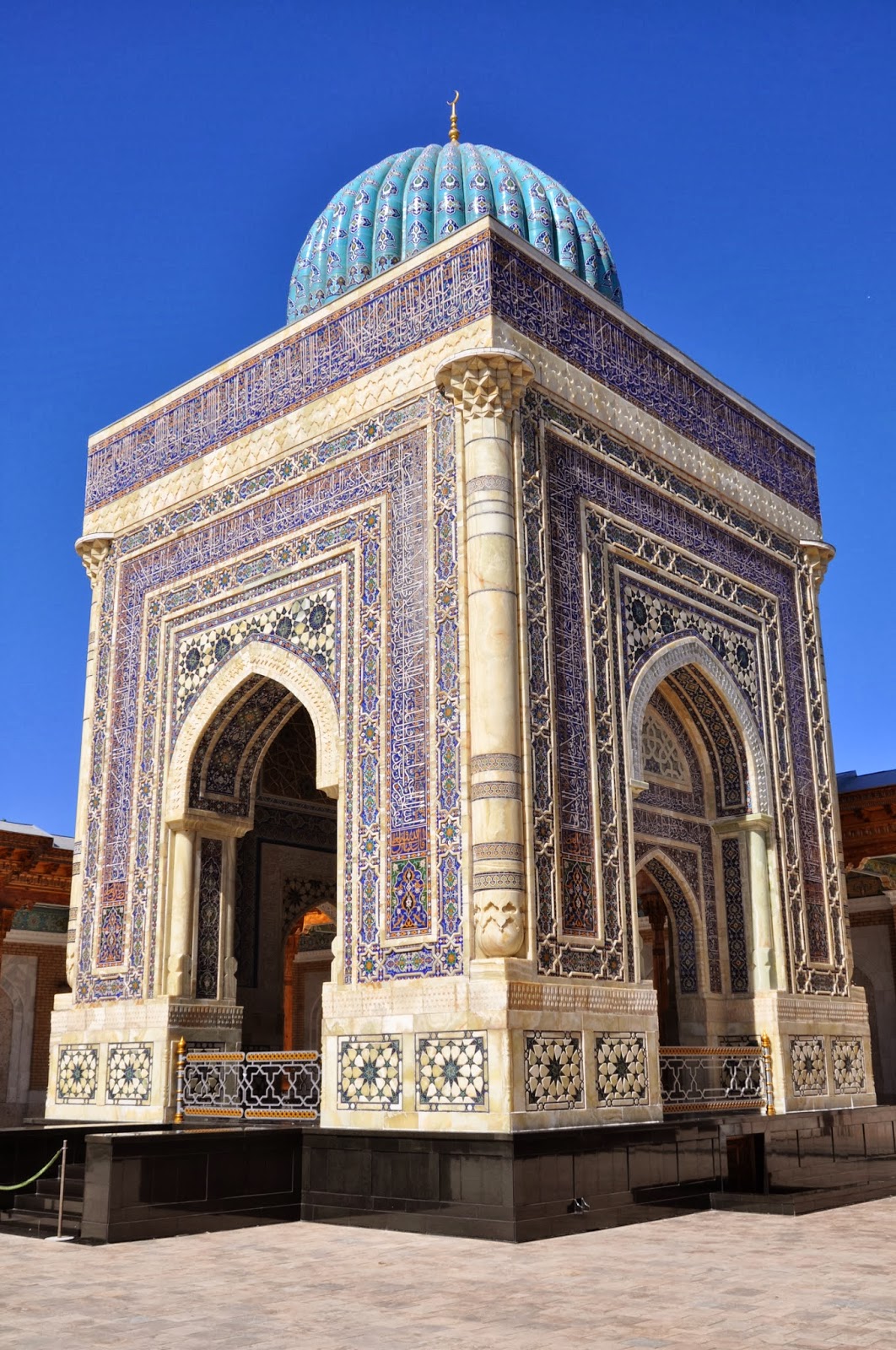
|
The Imam Al-Bukhari Memorial Complex
Muhammad ibn Ismail ibn Ibrahim Al-Bukhari (810-870) is well known in the Muslim world theologist of the 9th century, the compiler of the most authoritative collection of the Hadith (The Sayings of the Prophet Muhammad)
One of the most prominent specialists in hadith in the entire Muslim world, Imam al-Bukhari was born in Bukhara on July 21, 810, and died in the village of Hartang ( present- day Payariq district of Samarkand regio), 25 km from Samarkand, where he was buried in 870. Since that time this place has become one of the most revered places of Muslims around the world.
The time to restore historical justice with respect to the glorious heritage of Imam al-Bukhari came when Uzbekistan gained its independence and fairness. The government has paid great attention and respect for specialist in hadith (collector of hadith – sayings, attitudes and requirements of Prophet Muhammad), who is the world-famous and all his life and strength dedicated to knowledge. On 29 April 1997, the Resolution of the government of the Republic of Uzbekistan was adopted “ On celebrating the 1,225th anniversary of the birth of Imam al-Bukhari by Hijra” – the lunar calendar. In November that year the UNESCO General Conference adopts a resolution to participate in 1998 in the celebration of the 1,225th anniversary of the scholar Ismail al – Bukhari.
The majestic memorial at the tomb of Imam al-Bukhari was also built, made in the tradition of ancient architecture in Central Asia.
The total leased area of the monument is 10hectares. The complex is adjacent to the highway Samarkand – Imam al-Bukhari (25km).
Construction of the complex and landscaping activities were led by President Islam Karimov. In the construction of the complex folk artists and craftsmen of Samarkand, Bukhara, Khiva, Tashekent, Andijan, Kokand and Shahrisabz were involved. Based on national architectural traditions (arch, dome, quince and others) the mausoleum, mosque, an administrative building and others were built.
The main facade of the complex administrative building (size 106x12m) faces south. Entrance to the complex is through three large carved gates of the arched building. The main entrance through darvazakhana is erected by big arched avian in national style. In miensaray the dome is erected in diameter of 10.5m. On the front of the entrance portal there are skillfully written texts of the complex construction history in the Arabic and Latin script. At the entrance to large darvazakhana, there are administrative and other rooms on the right. On the main avenue of the entrance of the complex, a modern fountain is built. On the left there is a mosque, the old plane trees and the old havuz. Pathes of the courtyard enclosed with square limestone. In the central axis of the complex there is a mausoleum of Imam al-Bukhari. This structure in the form of a cube is topped with a seventeen- meter dome. The walls are decorated with light green, blue and white glazed tiles, marble, onyx and granite, floors are decorated with girih; in facing there is also widely used ganj. Inside, the dome is decorated with colorful ornaments. The outer dome of the mausoleum as well as the shrine of Temurids in Gur Emir is ribbed. The door on the right side of the mausoleum leads down to dakhma – a place of worship. On the right from the decorated light blue onyx sagan of the top floor there is the tomb of al Bukhari, covered with marble.
At the mikhrab’s niche, the kisva is hung – the cloth of Kaaba, presented by Saudi Arabia’s king Fahd ibn Abdullaziz to president Islam Karimov. The library contains unique samples of the Qur’an manuscripts, various editions, as well as samples of works of Imam al-Bukhari. Next to the Imam al-Bukhari’s complex there is a building of the “International Center Imam al- Bukhari”, created by order of the President of Uzbekistan Islam Karimov on 23 May 2008. The complex of Imam al – Bukhari is one of the largest and most unique buildings of this type created in our country over the past centuries. This complex, as President Islam Karimov said, is not only a place of holy worship but one of the most beautiful places in Uzbekistan, which will glorify us around the world. It will play a big role in good upbringing of the younger generation; will make everyone to think more deeply about life and eternity. |
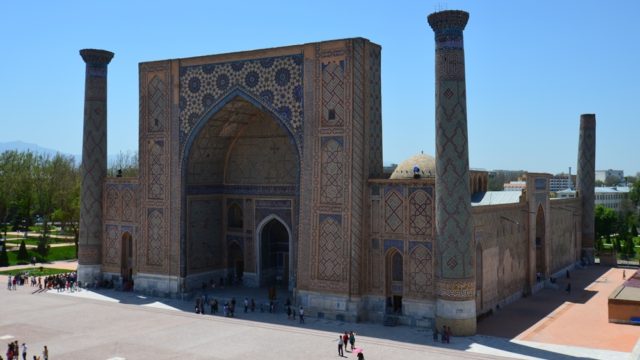 |
Ulughbek Madarsa
Mirzo Ulugbek (1409-1449), AmirTemur’s (1370-1405) grandson, started exlensive construction works in Samarkand, Bukhara, Shahrisabz and Gijduvan. Ulugbek Madrasa in Samarkand was constructed during three years (1417—1420) on the west side of the Registan square. It was one of classic education institutions of the East Inside there is a court yard with 54 cells (hujras), where 110 students lived. The architect of the building was Kavamiddin Shirazi, who served in the court of Shahruh, Ulugbek’s father. The scale of this madrassah can compete with the largest of Amir Temur’s constructions. |
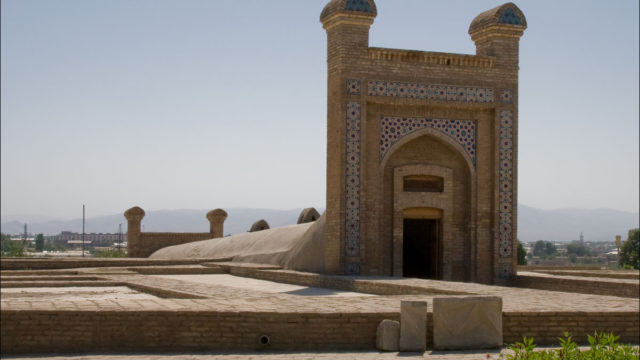 |
Ulugbek observatory
Ulugbek observatory is one of the unique examples of architecture of the XV century in Samarkand, this is the ancient astronomical observational construction. By order of Ulugbek, it was built in 1428-1429 on a hill Kuhak (Chupanota) in the form of a huge cylinder. As stated in the “Baburname” the structure was built in three floors of 30.4 m height . There were more than ten kinds of astronomical instruments and tools. The major among them was a close to sextant double quadrant with the length of 40.2 m.
The southern part of the quadrant is under the ground, the northern part rises from the ground at 30 meters. Quadrant is built with millimetre accuracy. One degree of the arc of circle of the device is 701.85 mm, one minute of the arc is 11.53 mm. The instrumental equipment of the observatory was the best in the Middle Ages. The device made it possible to determine the basic astronomical constants – the angle between the equator and the ecliptic, the annual procedural constant, the length of the tropical year, and other fundamental astronomical constants. The observatory had also small measuring instruments: armillary sphere, measuring tools of 2, 4 and 7 rings, triangular, solar and stellar clocks, astrolabes and other. With their help the Sun, Moon, planets and selected stars were monitored. The biggest astronomical work of Ulugbek “Ziji Kuragani” was written exactly in this observatory.
Construction and scientific activity of the observatory was connected with the names of famous scientists Giyasitdin Kashi, Kazizoda Rumi, Ali Kushchi and others gathered here on the orders of Ulugbek. The remains of the observatory were found in 1908 during excavations made under the direction of V.L. Vyatkin. In particular, they found a circular wall with a diameter of 48 m and one brick thickness, the remains lying in the centre of the main structure, divided into large halls and small rooms. According to Babur, their surface is decorated with tiles and mosaics. With a huge device, installed at the observatory, the movement of the sun, moon, planets and stars have been studied with high precision.
The observatory had a library. The sky with a star map, a globe with all continents, oceans, mountains, seas, countries were painted on the walls. Later, left unattended, the observatory has turned into ruins in the XVI century. Now the underground part of the quadrant of a length of about 11 m is preserved. Uzbek and foreign scientists conduct scientific research on the true type, internal structure, the basic construction of the observatory.
In 1964 a museum of Ulugbek was opened next to it. As a visual expression of the highest development of science, particularly astronomy, in the epoch of Timurids the Ulugbek’s observatory in Samarkand strikes the imagination of visitors and pilgrims.
Location: Samarkand, Tashkent Yuli Street, 7. Working hours: from 08.00 to 18.00. |
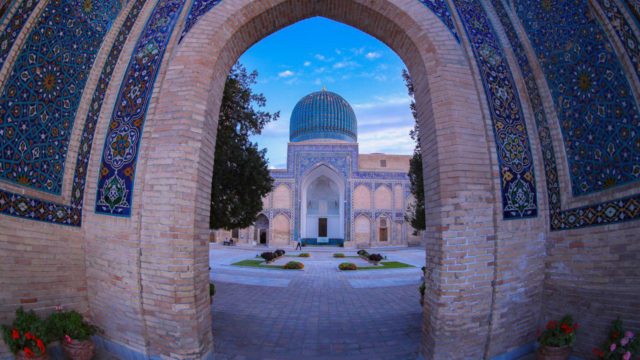 |
Gur-Emir mausoleum
The Gur-Emir mausoleum is considered a model architecture of Central Asia. The building was laid by the grandson and heir of Amir Temur – Muhammad – Sultan as a madrassah (construction started in 1401). However, Muhammad – Sultan fell ill and died while returning from a campaign to Asia Minor. For this reason, his madrassah by the order of Amir Temur was rebuilt and Muhammad – Sultan was buried there.
The famous historian of Temur, Sharafiddin Ali Yazdi wrote that “the dome of this building is high, like the sky, the lower parts of the building are decorated with gilt and turquoise patterns on the marble”. Later, there was buried (1405) Amir Temur himself. Later, during the reign of Ulugbek, by the order of his father, Shahrukh Mirzo (son of Amir Temur) the building was finally completed and turned into a mausoleum of Temurids. |

